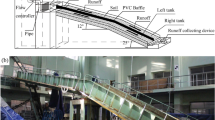Abstract
This research study used sewage sludge from urban wastewater treatment plants to restore road embankments. The results have been used to propose a series of basic principles for the application of sludge in this context. In the study, six experimental plots (each composed of one cut slope and one fill slope) were set up on a highway located in the province of Jaen (Spain). The soil and vegetation in the plots were restored by a conventional hydroseeding process, with each plot receiving a different sludge dosage. A control plot did not receive any treatment at all, whereas another plot was hydroseeded, but without any sludge added to the slurry mix. In the plots, soil evolution was controlled from the moment that the embankment was created and hydroseeded until the present. As part of the soil monitoring process, agronomic parameters and the heavy metal content of the soil were analyzed in the laboratory. Another parameter of analysis was the vegetation cover, which was studied on the basis of on-site visual inspections and the rasterization of images with a view to calculate the percentage of vegetation cover on each plot. Results showed the effectiveness of sewage sludge as an organic complement in the restoration of road embankments. Its viability is enhanced by the fact that the sludge can be applied with the same methods used in public highway construction. The results also showed the optimal sludge dosage to be used in the slurry mix during the hydroseeding process.


Similar content being viewed by others
References
Blunt, S. M., & Doken, T. C. (1994). Erosion of highway slopes in upland Wales: problems and solutions. Vegetation and slopes: establishment. Protection and ecology. In D. H. Barker (Ed.), Proceedings of Conference (pp. 95–107). Oxford.
Council Directive of 12 June 1986 on the protection of the environment, and in particular of the soil, when sewage sludge is used in agriculture (86/278/EEC).
De Oña, J., & Osorio, F. (2006a). Application of sludge from urban wastewater treatment plants in roads' embankments. Journal of Hazardous Materials, 131(1–3), 37–45.
De Oña, J., & Osorio, F. (2006b). Using waste to reduce slope erosion on road embankments. Transport, 159(Issue TR1), 15–24.
De Oña, J., Osorio, F., & Garcia, P. A. (2009). Assessing the effects of using compost–sludge mixtures to reduce erosion in road embankments. Journal of Hazardous Materials, 164(2–3), 1257–1265.
Dorgelo, J., & Leonards, P. E. G. (2001). Relationship between C/N ration of food types and growth rate in the snail Potamopyrgus jenkinsi (E.A. Smith). Journal of the North American Benthological Society, 20(1), 60–67.
Elliott, H. A. (1986). Land application of municipal sewage sludge. Journal of Soil and Water Conservation, 41, 5–10.
Eyheraguibel, B., Silvestre, J., & Morard, P. (2008). Effects of humic substances derived from organic waste enhancement on the growth and mineral nutrition of maize. Bioresource Technology, 99(10), 4206–4212.
Gerhardt, T., Spliethoff, H., & Hein, K. (1997). Thermische Nutzung vonKlärschlä mmen in Kraftwerksfeuer ungsanlagen. J Entsorgungspraxis, 3, 50–58.
De Lira, A. C. S., Guedes, M. C., & Schalch, V. (2008). Sewage sludge recycling in eucalypt plantation: Carbon and nitrogen [Reciclagem de lodo de esgoto em plantação de eucalipto: Carbono e nitrogênio]. Engenharia Sanitaria e Ambiental, 13(2), 207–216.
McGrath, S. P., Chang, A. C., Page, A. L., & Witter, E. E. (1994). Land application of sewage sludge: scientific perspectives of heavy metal loading limits in Europe and the United States. Environmental Review, 2, 108–118.
Morel, J. L., & Guckert, A. (1981). The influence of sewage sludge application on physical and biological properties of soils. In G. Catroux, P. L’Hermite & E. Suess (Eds.), Proceedings of a Seminar Organized Jointly by the Commission of the European Communities, Directorate-General for Science, Research and Development and the Bayerische Landdesanstalt für Bodenkutur und Pflanzènbau (pp. 25–42). Munich
Pengcheng, G., Xinbao, T., Yanan, T., & Yingxu, C. (2008). Application of sewage sludge compost on highway embankments. Waste Management, 28, 1630–1636.
Rivas, S. (1988). Bioclimatología, Biogeografía, y Series de Vegetación de Andalucía Occidental. Lagascalia, 15, 91–119.
Shen, J. F., Zhou, X. W., Sun, D. S., Fang, J. G., Liu, Z. J., & Li, Z. M. (2008). Soil improvement with coal ash and sewage sludge: a field experiment. Environmental Geology, 53, 1777–1785.
Singh, R. P., & Agarwal, M. M. (2008). Potential benefits and risks of land application of sewage sludge. Waste Management, 28(2), 347–358.
Sort, X., & Alcañiz, J. M. (1999). Land Degradation & Development, 10, 3–12.
Thomann, Ch. (1984). Experimental study on the use of urban sewage sludge on Mediterranean forests. In S. Berglund, R. D. Davis, & P. L’Hermite (Eds.), Utilization of sewage sludge on land (pp. 61–78). Lancaster: D. Reidel.
Veum, K. S., Goyne, K. W., Motavalli, P. P., & Udawatta, R. P. (2009). Runoff and dissolved organic carbon loss from a paired-watershed study of three adjacent agricultural Watersheds. Agriculture, Ecosystems & Environment, 130(3–4), 115–122.
Wang, M. J., & Jones, K. C. (1994). Uptake of chlorobenzenes by carrots from spiked and sewage sludge-amended soil. Environmental Science and Technology, 28, 1260–1267.
Zhou, Q., & Gao, Z. (1994). Compounds contamination and secondary ecological effects of Cd and As in soil alfalfa ecosystems. Journal of Environmental Sciences, 6, 330–336.
Acknowledgements
We gratefully acknowledge financial support for this work from the Andalusia Regional Public Works and Transport Ministry (G-GI1002/IDI0).
Author information
Authors and Affiliations
Corresponding author
Rights and permissions
About this article
Cite this article
Ferrer, A., Mochón, I., De Oña, J. et al. Evolution of the Soil and Vegetation Cover on Road Embankments after the Application of Sewage Sludge. Water Air Soil Pollut 214, 231–240 (2011). https://doi.org/10.1007/s11270-010-0419-8
Received:
Accepted:
Published:
Issue Date:
DOI: https://doi.org/10.1007/s11270-010-0419-8




